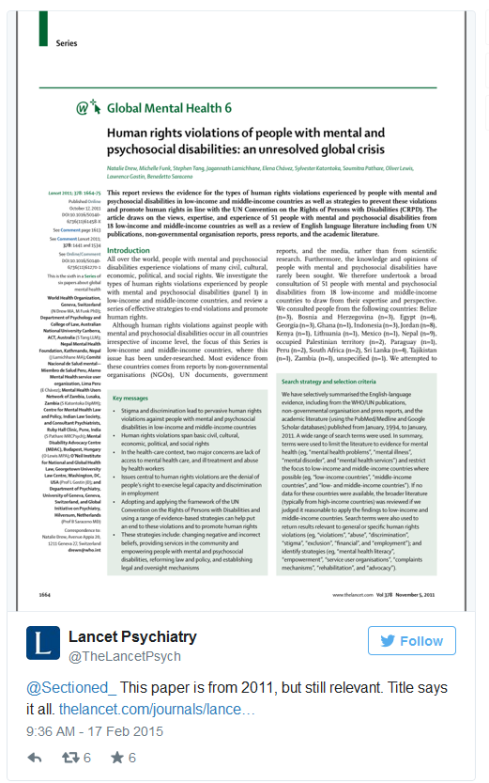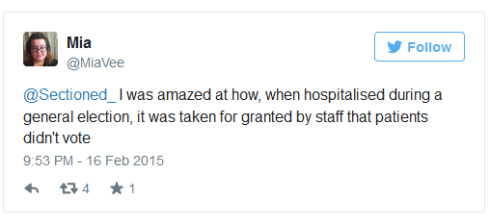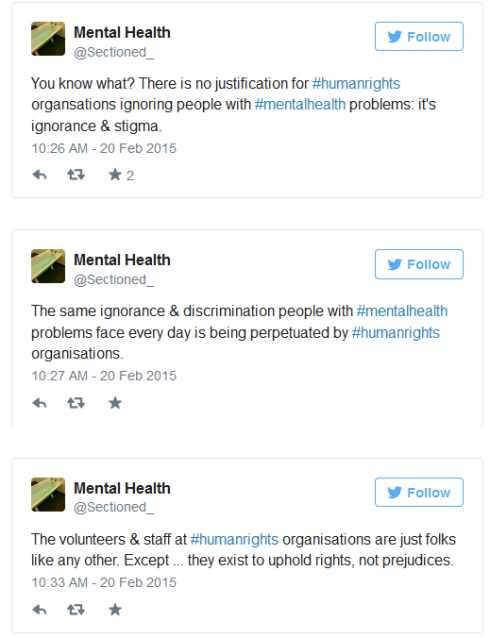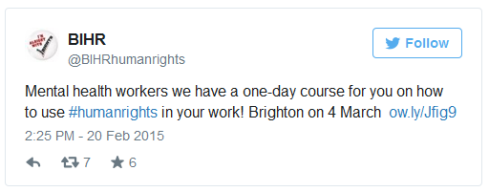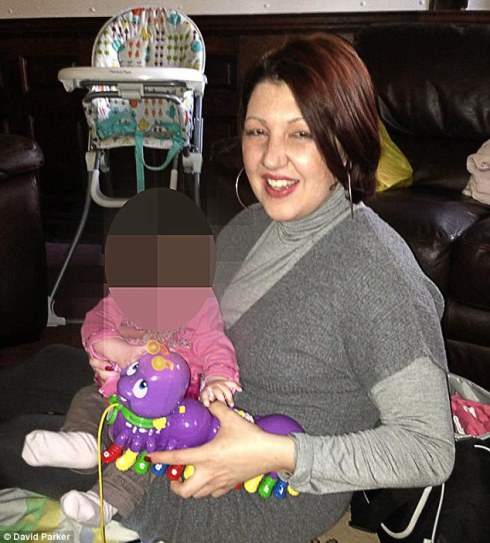Why aren’t human rights groups interested in the human rights of people with mental health problems, especially when there’s so much for them to get their teeth into? Is it just the same ol’ ignorance and prejudice?
When a human rights story is in the news, you’ll see me banging on about it on twitter and asking where the coverage of the human rights of mental health folks is. I’ll ask why human rights organisations don’t seem interested in this group of people, who can in many cases genuinely be classed as some of society’s most marginalised and vulnerable: sometimes locked up behind closed doors, often out of sight, with little credibilty and subject to state powers to impose forced treatment on people even when they have mental cacpacity. Why don’t we hear about that all day and all night from human rights organisations?
This silence from human rights groups is puzzling when mental health issues are receiving more publicity and prominence and where there is so very much for human rights groups to get their teeth into. That leads me to ask all sorts of questions. For instance:
- The Convention on the Rights of Persons with Disabilities
I’ll ask why human rights organisations don’t seem to be interested in a brand new developing area of rights, namely those under the Convention on the Rights of Persons with Disabilities (CRPD) which has been described as a paradigm shift in disability rights. Don’t they want to get in on the action on this hot new area, rather than sticking doggedly with familiar human rights aspects? Are human rights organisations bound to stay in the familiar niches they’ve carved for themselves, or will they look further afield?
- United Nations investigation into violations of the rights of disabled people
I’ll ask whether human rights organisation are looking at the fact that the UK is the very first country to be investigated by the United Nations for violations of the human rights of disabled people under the CRPD. Doesn’t that sound like an interesting and important human rights topic?
- Human rights section to the new Code of Practice to the Mental Health Act
I’ll ask what human rights organisations are doing about the brand new section at the front of the new Code of Practice to the Mental Health Act on … human rights. Isn’t it significant – something of note, something to promite – that the new CoP has at its very beginning a brand new section on human rights? I think so. Is it only me?
- Care Quality Commission’s new human rights-based approach
Are human rights organisations interested in the human rights-based approach all Care Quality Commission inspectors are to take to inspecting hospitals and other healthcare facilities?
- Restrictions placed on psychiatric detainees
Do they take an interest in the recent NICE guidance that all NHS hospitals should prevent smoking on their premises, even in the case of detained patients without leave and are there no human rights implications of that blanket policy (spoiler: yes)? And what of the blanket policies of some hospitals to remove patient phones or prohibit them from accessing social media whilst on ward?
-
Routine use of force medication
Forced medication is used on some psychiatric wards as a matter of routine, as a first resort rather than a last resort, even when people have the mental capacity to make medication decisions for themselves. Aren’t the human rights of people subjected to forced medication in psychiatric detention of interest to human rights groups?
-
Voting rights of psychiatric patients
Voting rights are meat and drink for human rights organisations. So why no campaigns or even interest in the voting righs of people with mental health problems?
Why is it? Why don’t human rights groups take an interest in those topics when there’s so much for them to get their teeth into and when mental health is such a hot topic at the moment, often in the news?
Mental health folks don’t seem to get a mention – unless we fall into an existing favoured category such as prisoners, death row inmates or deaths in custody
When I see human rights organisations talking about human rights, I notice time and again that, whilst all sorts of different niche groups and causes are trumpeted, mental health folks just don’t seem to get a mention – unless, that is, we fall into an existing favoured category, such as people in detention in prison or on death row, or deaths in custody. Why is that? And what – given important developments in human rights and current social and political changes giving mental health much more prominence – can be done to get violations of the human rights of mental health folks more of a focus and the enforcement of the human rights of mental health folks made into more of a priority?
Why am I told mental health folks are “too speciailst” when all sorts of other specialist groups are chosen for human rights campaigns?
I’ve tried to follow up with various human rights organisations to find out about the work they do on the human rights of mental health folks. I’ve tried. However, I’ve typically been ignored or, when I do get a response, I’m fobbed off with the line that people with mental health problems are a niche group that’s “too specialised” for them. This doesn’t seem to accord with campaigns run in respect of other “niche groups”, such as refugees, prisoners, LGBT people, trades union members, military personnel. Not at all. And it goes against the premise that human rights are most needed by those people who are most vulnerable – and people with mental health problems can be in very vulnerable postions. It’s niche groups who most need human rights.

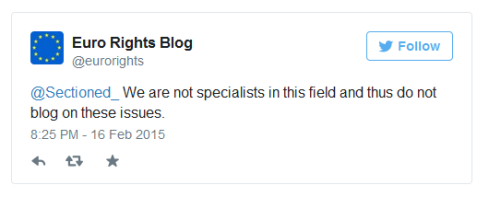
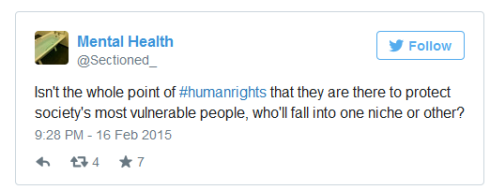 Why the seeming lack of interest from human rights organisations? Why are people with mental health problems being marginalised, even by those organisations and individuals who purport to champion society’s most marginalised and vulnerable people? Why – at a time of expanding human rights provisions for people with disabilities including mental health problems, at a time of increasing promimence for mental health issues growth, development and prominence of issues surrounding people with mental health problems – why are human rights organisations not swinging into action and grasping the opportunties available to do good, high profile work and make a real difference to the lives of mental health folks?
Why the seeming lack of interest from human rights organisations? Why are people with mental health problems being marginalised, even by those organisations and individuals who purport to champion society’s most marginalised and vulnerable people? Why – at a time of expanding human rights provisions for people with disabilities including mental health problems, at a time of increasing promimence for mental health issues growth, development and prominence of issues surrounding people with mental health problems – why are human rights organisations not swinging into action and grasping the opportunties available to do good, high profile work and make a real difference to the lives of mental health folks?
Could it be that human rights organisations are simply prey to the same ol’ same ol’ stigma and discrimination that blights the lives of mental health folks every day? Is it a case of priorities and people managing mental health problems just aren’t as important as other groups – even though we make up such a large minority of the population? I’m still trying to find an answer.
I’ll keep on trying. The human rights of people managing mental health conditions are too important to overlook.
.
.
.
Related links
.
Some human rights organisations
- Amnesty International (UK) – I’ve never received a response from UK Amnesty
- British Institute for Human Rights – This organisation DOES take a real interest in the human rights of people with mental health problems
- Equality and Human Rights Commission
- Eurorights @eurorights
- Justice Hub @justice_hub
- Liberty (formerly the National Council for Civil Liberties) – Liberty says mental health is “specialist” (whilst at the same time runnning campaigns for what could also be consider for “specialist groups” – currently trades union members, military personnel)
- Reprieve – This organisation focuses on the death penalty, torture, Guantanamo Bay, drones and secret prisons
.
.
Some human rights laws and conventions
- European Convention on Human Rights (ECHR) (European law)
- Human Rights Act 1998 (UK law)
- Mental Capacity Act 2005
- United Nations Convention on the Rights of Persons with Disabilities (CRPD)
- Universal Declaration of Human Rights
.
Some twitter musings on human rights for mental health folks:
- Musings on human rights for mental health folks & discussions with human rights organisations on whether they cover this topic (February 2015)
- Legal training for mental health nurses (7th December 2014)
- Tone policing in mental health – Adam Wagner (1st December 2014)
- Human rights and mental health (28th November 2014)
.

